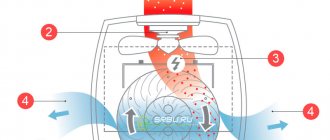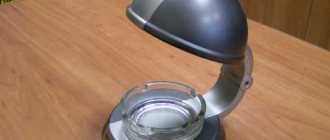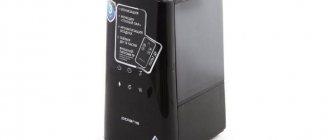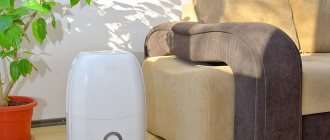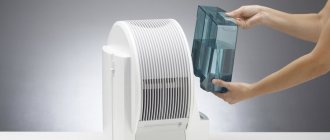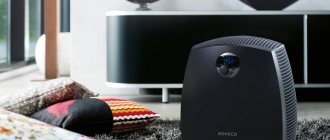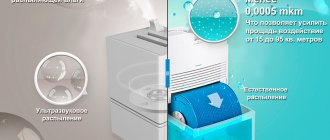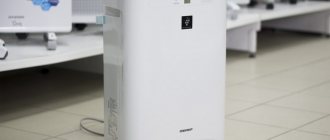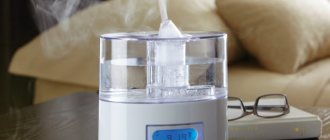In one of the previous articles, Nikita was surprised at the dirty air in Moscow (you can view the pollution index here). They say it’s a nightmare, a lot of harmful particles and you can’t breathe in it. And indeed it is.
What to do if your home air is polluted? Will a regular household cleaner do the job, or is it a waste of money?
We have found out in detail, measured and are ready to share the results of independent testing of one of the cheapest, and, at the same time, the most popular air purifiers - Xiaomi Mi Purifier 2.
ATTENTION. Testing is carried out at the expense of the editors without sponsors. The author is not interested in fraud, since he uses the tested gadget (purchased at his own expense) at home.
Air and its components: what kills us?
Conditionally harmful inclusions in the usual air that we breathe should be divided into 2 parts: inclusions from the external urban atmosphere and indoor pollution itself.
City air
The air “outside” the apartment must obey the rules described in GN 2.1.6.695-98 “Maximum permissible concentrations (MAC) of pollutants in the atmospheric air of populated areas” and a number of other regulatory documents.
According to this document, you can find almost anything outside. But in all emission zones, independent examination areas have been organized, which MUST ensure control and timely transfer of data to polluting organizations to correct the situation.
Home air
The air in our apartments is also standardized and complies with SanPiN 2.1.6.1032-01 “Hygienic requirements for ensuring the quality of atmospheric air in populated areas.”
Among the particularly dangerous air impurities characteristic of the home, it is worth mentioning formaldehyde, resins, dust (what did you think!) and a number of particles whose origin is associated with the degradation of synthetic materials: particles and fibers of plastic, asbestos, and other building mixtures.
Maximum permissible standards for components
Unfortunately, the already mentioned SanPiN 2.1.6.1032-01 does not include exact figures indicating the degree of air pollution. They are specified in GOST 12.1.005-88 “GENERAL SANITARY AND HYGIENIC REQUIREMENTS FOR WORK AREA AIR” and GOST 30494-2011 “RESIDENTIAL AND PUBLIC BUILDINGS. Indoor microclimate parameters."
According to GOST 30494-2011, the main pollutants are carbon dioxide CO2 (gas released during breathing) and CO (equivalent to emissions of finishing materials) with a maximum content for apartments of 400 cm3/m3 and 2–6 mg/m3. respectively.
The mentioned CO in real life is represented by so-called VOCs - these are gases and aerosols emitted by paints, varnishes, cleaning and disinfectants, building materials, furniture, office equipment, glues and adhesives.
For each substance, there are standards described in GOST 12.1.005-88, which can be inhaled or consumed in another way for a certain time without serious consequences for the body.
The problem with Russian regulations is the lack of mention of particle dispersion. The fact is that not only the chemical composition of impurities is important for the human body, but also the size of the inclusions.
Airborne particles are divided by size:
- large particles with a diameter > 10 µm
- PM10 fine particles with diameter
- PM2.5 fine particles with diameter
- ultrafine particles PM0.3 with a diameter
The most dangerous are the last 2 types.
Effect of PM2.5 particles on humans
PM2.5 particles are called the respirable, inhalable fraction. They are so small that they pass through biological barriers in our body: the nasal cavity, upper respiratory tract, bronchi and enter directly into the alveoli of the lungs, from where they enter the blood.
Ultrafine particles act in a similar way, but tend to accumulate in the lungs, and when they enter the blood, they act immediately and can cause an oxidative process.
How to deal with harmful impurities
There are several types of home air purification devices, among which filtering devices are deservedly more popular. And that's why.
Air washers force air through a water filter, removing large particles from it. Have to wash it often.
Electrostatic cleaners first charge the air they pass through, then attract particles to the oppositely charged cleaning plate. They produce too much ozone and require constant cleaning.
Photocatalytic purifiers use a photofilter, which, by releasing certain particles, causes impurities to decompose into components, oxidize and settle on the walls of the filter. They require enormous power and are most often ineffective.
Ionic purifiers must charge air impurities in order to attract them with a special filter. Alas, not all impurities can be charged, and in general, filters of this type have unconfirmed effectiveness.
Filter purifiers pass air through several filters that capture the appropriate types of particles. Requires periodic filter replacement.
Inertial cleaners accelerate the air flow in the form of a cyclone so that the dust settles on the filter walls. Does not remove small particles.
We are testing Xiaomi Mi Purifier 2. Is there any benefit?
Xiaomi Mi Air Purifier 2 is the second modification of the air purifier from Xiaomi, designed for less polluted conditions than Beijing and Shanghai. In addition, international experts participated in its certification, so the results of the device meet international requirements, unlike previous modifications.
The device is designed to clean rooms up to 330 cubic meters in volume, or up to 46 square meters in area, using a replaceable filter combining HEPA (fine filter) and carbon.
According to official data, the purifier can purify the air from small particles hazardous to health in the categories PM0.3 - up to 99.5%, PM2.5 - up to 99.7%, formaldehyde - up to 91%, large particles hazardous to health - up to 100% .
Using the proprietary MiHome and built-in sensors, the device reports data on temperature and humidity in the room and the concentration of PM2.5 particles. In addition, if open data is available, it is possible to find out information about the air quality outside the window.
In fact, the main sensor is a dust sensor, and cannot detect the type of particles. Therefore, the device's own data are incomplete for accurately assessing indoor air quality.
However, this is enough to understand the effectiveness of the filter. No one has canceled subjective assessments either.
ATTENTION. Xiaomi Mi Purifier measures the amount of PM2.5 particles not in SI units! The values shown are the air quality index according to The World Air Quality Index .
Summary
You should choose an air purifier based on the size of the room, your personal sensitivity to allergens and pollutants, and how important monitoring of parameters such as humidity, temperature and PM2.5 levels is to you.
- For large apartments and offices, it is better to choose Pro or even MAX models. For smaller rooms, depending on their area, use Air Purifier 3 or 2.
- If you are particularly sensitive to pollution and allergens, it is better to purchase a model with a higher level of clean air supply (for example, take, all other things being equal, Air Purifier 3 instead of Air Purifier 2).
- If you want to monitor the level of pollution and other indicators in real time, then any model from the line will suit you, except the Air Purifier 2/2H.
Test 1. Own readings, normal conditions
The first home test was carried out in an ordinary room in a city apartment in a district of Ulyanovsk under construction. The local air cannot be compared with Moscow - less than a kilometer from the Volga, the winds of the city on seven hills and the vast park area cope well with urban impurities.
The switching-on was carried out in a closed room, which was not ventilated for 10 hours, and was not cleaned for a week (the authors make incredible self-sacrifice for you) for sufficient accumulation of dust.
Left - readings before switching on, right - after cleaning
As can be seen from the results, the home accessory copes well with common household impurities in the form of fine dust and “repair” components - substances emitted by finishing materials.
The next test was carried out with an open window, simulating external urban conditions. Outside the window there is complete calm, a hot day (rising currents from the ground raise the remaining amount of dust, there is not much of it).
Left - readings before switching on, right - after cleaning
The result is not as happy as in a completely enclosed room. However, the level of impurities does not exceed the standards established in GOST. Using a cleaner slightly reduces their level.
Results of the rating of Xiaomi air humidifiers in 2021
| Humidification area | Noise level | Duration of continuous operation | Average score | |
| Xiaomi DEM-F628S | 5 | 5 | 5 | 5 |
| Xiaomi Deerma DEM-F301 | 4 | 4 | 3 | 3,7 |
| Xiaomi Mijia Air Humidifier 4L (MJJSQ02LX) | 4 | 3 | 4 | 3,7 |
| Xiaomi VH Man | 4 | 5 | 5 | 4,7 |
| Xiaomi Sothing Geometry Desktop | 3 | 5 | 3 | 3,7 |
| Xiaomi Solove H1 | 5 | 4 | 4 | 4,3 |
| Xiaomi CJXJSQ02ZM | 3 | 5 | 5 | 4,3 |
| Xiaomi SCK0A45 | 4 | 4 | 3 | 3,7 |
| Xiaomi CJJSQ01ZM | 5 | 4 | 4 | 4,3 |
The best budget Xiaomi humidifier is the DEM-F628S model. It is characterized by quiet and long-lasting operation.
If the main selection criterion is the portability of the device, you should pay attention to the Xiaomi VH Man. In addition, this is the only model in our selection that has a wide selection of colors.
In the category of the best Xiaomi smart humidifiers, two models received the same average score: Xiaomi CJXJSQ02ZM and Xiaomi CJJSQ01ZM. The first is quieter and moisturizes longer on one fill, the second is intended for large areas.
Although an air humidifier does not serve as a purifier, it is a necessary thing for asthmatics and allergy sufferers. We hope our rating will help you choose and buy a humidifier that suits you in the store.
Test 2. Own readings, polluted air
Additional testing of the Xiaomi purifier was carried out to study its performance with the most polluted air.
Tobacco smoke, oil smoke, and burnt wood were used as air impurities. Such components qualitatively simulate emissions from thermal power plants, boiler houses and enterprises.
Left - readings before switching on, right - after cleaning
The effectiveness of the device is confirmed: Mi Purifier 2 copes with any smoke in approximately the same time, regardless of its density and saturation.
The built-in sensor probably measures an average value, since lighter tobacco smoke should settle on the filters more slowly.
What is necessary to reduce the concentration index of particles with a diameter of 2.5 microns [micrometers] from 410 to an acceptable 44 can be seen in the screenshots. However, in real conditions, longer time may be required since smoke uniformity was controlled subjectively.
The subjective assessment was made by a person entering the room after complete cleaning. There are no smoke odors, but a close inspection of the purifier suggests it needs to be ventilated.
How to choose a humidifier for your home
Before moving on to the reviews, let’s look at what parameters you should pay attention to before purchasing a humidifier:
Productivity . Reflected in the amount of water that evaporates per hour. The more water the device blows out, the faster you will feel the effect of its use.
Noise during operation . Since the humidifier works both day and night, it is important to choose a model that will not interfere with your comfortable sleep. Choose devices with a noise level of up to 35 dB (comparable to a muffled conversation).
Humidification area . One device is designed to humidify one room. In addition, if you have a room of 25 sq. m, and the maximum humidification area is 15 square meters. m, the device needs to be replaced.
Tank volume . This indicator determines how often you will add a new portion of water.
Energy consumption . The lower the power of the humidifier, the more economical it uses electricity. The presence of a hydrostat will help control energy costs: you set the desired humidity level, and when it is reached, the device will automatically turn off.
Availability of UV lamp . It disinfects water and prevents its spoilage.
Placement method . There are two types of humidifiers: floor-standing or tabletop. The former are often cheaper, the latter are more compact. There are also universal models that can be placed both on the floor and on the bedside table.
Dimensions . This parameter should be taken into account when choosing a location. This is especially true for those who have a small apartment.
Also pay attention to the following product characteristics (the choice depends on personal preferences):
Control type : using a handle, touch screen, remote control, mobile application.
Availability of additional functions : built-in timer, ionization, integration into the “smart home” system, container for aromatization, low water level indication, etc.
Test 3. Industrial grade laboratory tests
This is how PM2.5 particles work. To confirm the functionality of the device, we used the help of an industrial cleanliness laboratory at a local company located near where I live.
The device was placed in a sealed room with a volume of 20 cubic meters, filled with air purified from impurities and PM10/2.5/0.3 particles.
Test substances were introduced into the room one by one. Cleaning percentage:
- Ammonia - 92%
- Hydrogen sulfide - 97%
- Phenol - 97%
- Methane - 99%
- Carbon dioxide - 98%
- Formaldehyde - 95%
- PM10 - 98%
- PM2.5 - 97%
- PM0.3 - 86%
The results are slightly worse than those officially declared, however, they do not reduce the effectiveness of the device, since the content of introduced substances after purification does not exceed the permissible limits.
How we evaluate the best Xiaomi air humidifiers for apartments
To determine which air humidifiers are better, we selected parameters that were significant, in our opinion, by which we evaluated each model relative to others in its category. For one criterion - maximum 5 points. The rating system included:
Humidification area: the larger, the higher the rating.
Noise level: the louder it is, the lower the rating.
Duration of continuous operation: the longer the device operates without adding a new portion of water, the higher the rating.
We divided all models into three mini-ratings of air humidifiers: budget, compact and smart. So, let's start with inexpensive devices.
